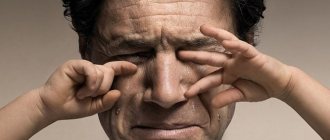When a person has a phobia, they often shape their life to avoid what they perceive to be dangerous. The imagined threat is greater than any real threat posed by the cause of terror.
Phobias are diagnosed mental disorders.
When faced with the source of a phobia, a person experiences severe stress. This can interfere with their normal functioning and sometimes lead to panic attacks.
In the United States, approximately 19 million people suffer from phobias.
The influence of a phobia on a person’s life
A phobia is a protective reaction of the body. It is based on a sense of self-preservation, insurance against experiences and unpleasant sensations. Therefore, it cannot be said that this fear is a bad feeling.
Sometimes fear of change allows you to make more informed decisions, objectively assess the chances of success, be critical of opportunities and respond correctly to certain situations. Often this phobia helps prevent rash actions that can lead to bad consequences in the future.
Fear of changes in life can add a drop of common sense, as well as pragmatism in assessing external factors. Sometimes it happens that changes become turning points. They change our perception. Therefore, it is very important to take them seriously. After all, some decisions are made only once and for all. At the same time, fear helps not to make a fatal mistake that a person will regret for the rest of his life.
If we look at this issue from a different angle, then change is a step towards movement in life, some kind of progress. Note that you can freeze for a very long time, waiting for active actions on the part of other people. Only if you look fear in the face can you learn to manage your life, set goals and achieve them. Of course, not all steps will be correct, but mistakes are natural for each of us. Whatever one may say, you can’t do without them.
It very rarely happens that success and happiness flow into the hands of those who do not make any efforts and do not take risks. Only through a large number of attempts can you get the desired result. Failures should be perceived as moments that should be taken into account in the future.
Origin theories
Psychoanalysis
Psychodynamic theory (the same psychoanalysis) is not scientifically recognized, but it has a good chance of existence. Its essence lies in the fact that a person unconsciously displaces the true causes of fear into the unconscious. And then it transfers it to a previously indifferent object, object.
To make it clearer, I will give an example. A man is afraid of castration or erectile dysfunction (that is, impotence). Why does he repress thoughts about it, hoping that this will never happen to him.
But the experiences don’t actually go away; the charge of energy remains in the body. But he needs to find a way out. In this case, horror may suddenly appear at the sight of spiders, kittens, bright sun, and so on.
Evolutionary
In ancient times, in order to survive, a person had to beware of foreign tribes, even very cute cubs of predators and large animals in general. Heights, fire, cold, darkness, etc. Otherwise, there could be no talk of any evolution; everyone would have died out even then.
Therefore, experts are inclined to believe that even the most ridiculous phobias in modern humans come from our ancestors, which were passed on to us at the genetic level. It’s just that the objects are completely different due to the changing conditions in which we now live.
Genetic
She suggests that the tendency to phobic reactions is inherited. But it’s difficult to judge exactly which way.
That is, a person can be incredibly afraid of blackbirds because his mother suffered from some kind of mental or nervous disorder. This is why he was included in the risk group, since he had a high probability of receiving a similar diagnosis.
Or simply, as a child, he saw how she reacted to birds, which is why he adopted the method of behavior, considering it correct.
Children are not able to process the information received using criticism and logic. Moreover, if an adult is significant to him, he then becomes a role model.
Behaviorist
Behaviorists believe that a person “earns” a phobia during life, denying heredity and so on.
She simply learns to react with fear to certain stimuli that once in the past caused a storm of emotions. Therefore, if you find yourself in a similar situation, a reaction occurs automatically.
Why is it worth overcoming fear?
Many successful individuals have experienced repeated failures on their path to success. They had to risk everything to achieve what they wanted. Sometimes it is the fear of change, the fear of the new that paralyzes the will and puts up barriers. Only by overcoming this phobia can you move confidently towards the future, without fear of circumstances. Fear of change can cause significant difficulties in romantic relationships, career advancement, and social life. As a result, a person already gets used to the routine schedule of the day. He reacts very sharply to any attempts to change anything. Because of the fear of change, a person can deprive himself of happiness. As a result, he remains alone for a long time.
Methods for dealing with panic attacks
As you remember, causeless anxiety usually takes you by surprise. When I was completely unprepared for such a turn of events and calmly, say, drank tea and cookies at a party. And then suddenly it begins to seem that control over the body is lost and that, most likely, death is already two steps away.
This is a truly difficult condition, but it is quite possible to cope with it on your own. So, the main methods that will help you regain peace of mind and the ability to think rationally:
Distracting attention
Judging by the name, I think you guessed that if you have severe anxiety, you should try to distract yourself with something else. Preferably positive and funny.
It is clear that during an attack there is absolutely no time for jokes, but try to occupy yourself with searching for answers to some simple questions. Starting from what day it is, how many windows are in the room, where you are and what color socks the interlocutor is wearing.
It seems like such simple nuances, but they will distract you from your worries. Your brain will actively engage in work, which will allow the body to gradually stabilize. Remember, when emotions run high, the best way to bring them back to normal is rationalization.
If confusion makes it impossible for you to come up with questions and tasks for yourself, switch to sensations. Apply a warm object or a cold object to the skin in different places.
The best, most sensitive places are the stomach, wrist, and temples. Pinch yourself, feel the boundaries of your body. Then you will not think that you are a solid “lump” of horror and anxiety.
Breath
Slow down your breathing. Turn on the timer and try to take such slow and deep breaths in and out that there are no more than 8 to 9 of them per minute. Then try to experiment and breathe first with your diaphragm and then with your stomach. Pay close attention to how your muscles stretch, what you feel and what you think.
You will learn more about calming and stress-relieving breathing techniques in this article. By the way, practice meditation. There is nothing complicated about it, but you will learn to achieve inner balance. You will get the simplest methods designed for beginners from the article about a popular method of meditation.
"Paper bag"
This method is familiar to us thanks to American films. When someone, when experiencing PA, grabbed a paper bag and breathed into it frequently to calm down.
But such a package is not always at hand. Therefore, it will be fine if you just put your palms to your face and try to breathe in them. The effect will be the same.
The secret of this technique is that by exhaling excess oxygen, a person restores the gas balance in the blood. That's why it returns to normal.
Bystander
To control your condition and not do anything stupid. Let’s say, while running around screaming and begging for help, take a piece of paper with a pen and write down everything that comes to mind.
In the process of writing, you distance yourself from your state, as if you will observe it from the side. And this will help put your thoughts in order.
Anger
When anxiety increases, adrenaline is produced in the body. It is he who makes our heart beat at crazy speed. Feeling dizzy due to an increase in the amount of oxygen in the blood, etc.
And in a moment of rage, strong anger, a surge of norepinephrine occurs. It constricts blood vessels and affects blood pressure. In general, in a moment of panic, if you manage to become genuinely angry, you will stop, so to speak, the spinning of the flywheel of uncontrollable horror. And you will gradually return to normal.
You just need to retire and address the PA as a real interlocutor. If possible, say out loud everything you think. About how she got you and how long it will last. The main thing is to do it sincerely.
It is important to clarify that the above techniques allow you to bring your feelings back to normal if you are suddenly seized by anxiety. But if you suffer from a phobic disorder, be sure to consult a specialist.
Reasons for the development of a phobia. Why might fear arise?
Now we will tell you why there is a fear of change; we will consider the main reasons below. Note that the root of the problem lies very deep in the subconscious. Possibly since childhood. At some point, natural defense mechanisms simply began to block the path to a new life. At the same time, a person experiences a feeling of comfort only in a routine situation and a familiar environment.
Why might a phobia occur? Fear of change can manifest itself after some traumatic situation that literally “knocked you off track” and significantly changed your life. Such changes remain in the child’s memory for a long time as an event that changed their worldview. Usually the child evaluates everything that happened before as good, but after as bad. For example, parental divorce can have this effect on a child. This destroys ideals and a harmonious way of life.
Such an unpleasant sensation can remain in the memory for a long time and cause harm even in adulthood. After such an event, a person tries to create conditions around himself that will not change and cause discomfort. External influence, regardless of its nature, will be perceived only as undesirable.
Causes
It is unusual for a phobia to begin after age 30, and most begin in early childhood, adolescence, or early adulthood.
They can be caused by stressful situations, frightening events, phobias of parents or family members who have a phobia that the child can “learn.”
Specific phobias
They usually develop between the ages of 4 and 8 years. In some cases, this may be the result of a traumatic early experience. One example is claustrophobia, which develops some time after a younger child experiences unpleasant sensations in a confined space.
Phobias that arise in childhood can also be caused by phobias of family members. For example, a child whose mother suffers from arachnophobia is much more likely to develop the same phobia.
Complex phobias
More research is needed to determine exactly why a person develops agoraphobia or social anxiety. Researchers now believe that complex phobias are caused by a combination of life experiences, brain chemistry and genetics.
They may also be echoes of the habits of early humans, left over from a time when open spaces and unknown people in general posed a much greater threat to personal safety than they do in the modern world.
How the brain works during a phobia.
Some areas of the brain store memory of dangerous or potentially fatal events.
If a person experiences a similar event later in life, these areas of the brain recall the stressful memory, sometimes several times. This causes the body to experience the same reaction.
In a phobia, the parts of the brain that deal with fear and stress continue to inappropriately recreate the frightening event.
Researchers have found that phobias are often associated with the amygdala, which is located behind the pituitary gland in the brain. The amygdala can trigger the release of “fight or flight” hormones. This puts the body and mind into a state of heightened alertness and stress.
Personality characteristics that influence the development of phobias
Also, such a phobia can develop due to the personal characteristics of each person. Now let’s look at the personal qualities and character traits against which fear of change develops:
- Rigidity of the nervous system.
- Increased suspicion. Everything that happens is suspicious.
- Indecisiveness.
- Conservative. Tendency to ideological attachment to living conditions and established traditions.
- Increased suspiciousness.
- Indecisiveness. Difficulties arise in the process of resolving various issues.
- Increased level of anxiety. A constant feeling that some kind of danger is approaching.
- Low self-esteem. A person feels unable to take any actions or changes in life.
- Inability to leave your comfort zone. A person builds a barrier around himself.
- Excessively high level of responsibility.
Sometimes the emergence of fear can be triggered by a not entirely successful experience. As a result, a person gives up. After which there is no desire to try anything, so as not to cause discomfort to yourself. This happens because a person's perception is frozen at one moment. Such one-sided judgment leads to the emergence of neophobia.
Fear of change. How does it manifest?
This type of fear often arises in front of relevant situations. For example, if a man has led a bachelor’s lifestyle for a long time, then at the moment of talking about the wedding he may show signs of a phobia. Even if a person does not find any compelling reasons in this case, he still feels discomfort in the face of something new in life.
Fear of change can be divided into two categories: fear of change in the individual himself and fear of change in external conditions. Changes entail changes in life (in relationships, for example, with friends or acquaintances). When experiencing fear, a person perceives everything new as an additional burden to which one must get used. Sometimes during such periods an internal struggle begins to restore stability. The fear of changing oneself due to impending changes becomes more powerful. The external environment is not as important as internal control. A sensitive person perceives everything as a threat to himself, his habits and feelings.
What is the difference between a phobia and fear?
Phobias, unlike fears, are irrational in nature, and taking them under your own control is very difficult. Fear is a kind of protective mechanism that is triggered at the moment of danger and is a tool that saves a person from committing rash acts and allows one to save life in a critical situation. As a result of short-term stress, the concentration of cortisol and adrenaline increases, which allows the body to quickly come to a state of combat readiness, cope with the aggressor or overcome an obstacle.
You can overcome fear through fairly simple methods, such as logical arguments. In the case of a phobia, such methods are often powerless, and the support of highly qualified specialists is required to eradicate the problem. Psychotherapy involves re-experiencing traumatic events in order to rethink and consciously change the attitude towards the irritating factor. In difficult situations, the intervention of a professional hypnotist is necessary.
Symptoms of a phobia
How does this phobia manifest itself? Its symptoms are as follows:
- shiver;
- stupor;
- dyspnea;
- increased sweating;
- cardiopalmus;
- pain in temples:
- heartache;
- absent-mindedness;
- numbness in fingertips.
Such signs are nonspecific. They can appear in many other conditions and diseases. Although they can be used to diagnose fear in a person.
Internal mental symptoms are various. They vary depending on the person and their response to fear. Typically, signs range from absent-mindedness to anxiety with panic attacks and other negative consequences.
Overcoming fear
What are the known ways to combat the fear of change? We'll talk about this later. People who are afraid of change find it difficult to achieve goals and live life to the fullest. Therefore, it will be useful for them to learn how to overcome a phobia. Of course, fear of change cannot be treated with medications. Since they not only will not help, but can also cause addiction in sensitive individuals. Typically, psychological techniques are used in the treatment of phobias. They allow you to formulate behavioral tactics and sort out all the problems piece by piece.
Methods of influencing a phobia. What are the ways to fight?
Fear of change often causes a lot of trouble for a person. Therefore, we invite you to pay attention to effective methods of influencing this type of phobia:
- Make lists. Any event has its pros and cons. To do this, write them down in separate columns. As you form your thoughts, consider the possible consequences of change. It is possible that you realize that not everything is so scary.
- Make plans. A person should determine for himself whether he needs to get rid of a phobia. In the process of working with a psychologist, you should analyze all the mistakes that the individual made due to fear. It’s worth making plans for your future life and following this list unswervingly.
- Seize the moment. If you have plans for success, then you should not miss them out of fear.
- Analyze situations. You should be aware of situations in order to understand what a person gave up that he could have received if he did not have such fear.
- Look fear in the face. Sometimes turn on your pragmatic mind, boldly move forward, not paying attention to your emotions. Then sooner or later you will be able to overcome the phobia.
- Look at situations objectively. Consider each current case from different angles. Try to look at the situation objectively.
Treatment
Phobias are treatable, and sufferers are almost always aware of their disorder. This is very helpful in diagnosis.
Talking to a psychologist or psychiatrist is a useful first step in treating an already identified phobia.
Unless the phobia is causing serious problems, most people find that simply avoiding the source of the fear helps them maintain control over the situation. Many people with specific phobias do not seek treatment because these fears are often treatable.
It is impossible to avoid the occurrence of some phobias, as is often the case with complex phobias. In such cases, talking to a mental health professional may be the first step toward recovery.
Most phobias can be cured with appropriate treatment. There is no single treatment that will work for every person with a phobia. For treatment to work, it must be tailored to the needs of the individual.
A doctor, psychiatrist, or psychologist may recommend behavioral therapy, medications, or a combination of both. Therapy aims to reduce symptoms of fear and anxiety and helps people manage their reactions to the object of their phobia.
Medicines
The following medications are effective in treating phobias.
Beta blockers: This may help reduce the physical signs of anxiety that may accompany a phobia.
Side effects may include upset stomach, fatigue, insomnia, and cold fingers.
Antidepressants: Serotonin repeat inhibitors (SSRIs) are commonly prescribed to people with phobias. They affect serotonin levels in the brain, and this can lead to improved mood.
Initially, RSB may cause nausea, trouble sleeping, and headaches.
If an SSRI doesn't work, your doctor may prescribe a monoamine oxidase inhibitor (MAOI) to treat social phobia. Persons on board a MAOI vessel may be required to avoid certain types of food. Side effects may include dizziness, stomach upset, anxiety, headaches and insomnia.
Taking a tricyclic antidepressant (TCA), such as clomipramine or anafranil, has also been found to relieve phobia symptoms. Initial side effects may include drowsiness, blurred vision, constipation, difficulty urinating, irregular heartbeat, dry mouth, and tremors.
Tranquilizers: Benzodiazepines are an example of a tranquilizer that may be prescribed for a phobia. This may help reduce anxiety symptoms. People suffering from alcohol dependence should not be given sedatives.
Behavioral therapy
There are a number of therapeutic options for treating phobias.
Desensitization or exposure therapy: This can help people with a phobia change their reaction to the source of the fear. They are gradually exposed to the causes of their phobia through a series of escalating steps. For example, a person with aerophobia or fear of flying can take the following steps under the guidance of an instructor:
- First they will think about flying.
- The therapist will have them look at photographs of airplanes.
- The man will go to the airport.
- Further escalation will occur while sitting in a simulated aircraft training cabin.
- Finally they get on the plane.
Cognitive behavioral therapy (CBT): A doctor, therapist, or counselor helps a person with a phobia learn different ways of understanding and responding to the source of their phobia. This can make it easier to overcome difficulties. Most importantly, CBT can teach the person experiencing a phobia to control their own feelings and thoughts.











